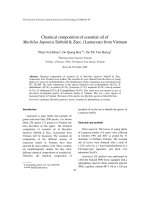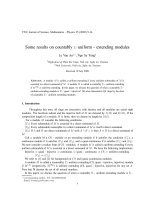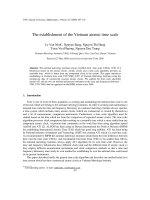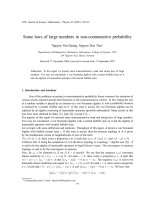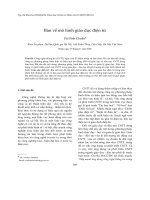Tài liệu Báo cáo "Some laws of large numbers in non-commutative probability " docx
Bạn đang xem bản rút gọn của tài liệu. Xem và tải ngay bản đầy đủ của tài liệu tại đây (306.61 KB, 9 trang )
VNU Journal of Science, Mathematics - Physics 23 (2007) 159-167
Some laws of large numbers in non-commutative probability
Nguyen Van Quang, Nguyen Duy Tien
∗
Department of Mathematics, Mechanics, Informatics, College of Science, VNU
334 Nguyen Trai, Hanoi, Vietnam
Received 15 November 2006; received in revised form 12 September 2007
Abstract. In this report we present some noncommutative weak and strong laws of large
numbers. Two case are considered: a von Neumann algebra with a normal faithful state on it
and the algebra of measurable operators with normal faithful trace.
1. Introduction and notations
One of the problems occurring in noncommutative probability theory concerns the extension of
various results centered around limit theorems to the noncommutative context. In this setting the role
of a random variable is played by an element of a von Neumann algebra
A, and a probability measure
is replaced by a normal faithful state on it. If this state is tracial, the von Neumann algebra can be
replaced by an algebra consisting of measurable operators (possible unbounded). Many results in this
area have been obtained by Batty [1], Jajte [2], Luczak [3],
The purpose of this report is to present some noncommutative weak and strong laws of large numbers.
Two case are considered: a von Neumann algebra with a normal faithful state on it and the algebra of
measurable operators with normal faithful trace.
Let us begin with some definitions and notations. Throughout of this paper,
A denote a von Neumann
algebra with faithful normal state τ . If this state is tracial, then the measure topology in A is given
by the fundamental system of neighborhoods of zero of the form
N(, δ)={x ∈A: there exists a projection p in A such that xp ∈A ||xp|| and τ (1 − p) ≥ δ}
It follows that
˜
A, being the completion of A in the above topology is a topology
∗
- algebra (see [7]).
˜
A
is said to be the algebra of measurable operators in Segal-Nelson's sense. The convergence in measure
topology is said to be the convergence in measure.
Now, let
x
n
,x be elements in A (or
˜
A if τ is tracial). We say that the sequence (x
n
) converges
almost uniformly to x (x
n
→ x a.u) if , for each >0, there exists a projection p ∈Asuch that
τ(1 − p) <;(x
n
− x)p ∈Aand ||(x
n
− x)p|| → 0 as n →∞. The sequence (x
n
) is said to be
bilaterally almost uniformly convergent to x (x
n
→ x b.a.u) if, for each >0, there exists a projection
p ∈Asuch that τ(1 − p) <; p(x
n
− x)p ∈Aand ||p(x
n
− x)p|| → 0 as n →∞. We have that
||p(x
n
− x)p|| ||p||.||(x
n
− x)p|| ||(x
n
− x)p||.
∗
Corresponding author. E-mail:
159
160 N.V. Quang, N.D. Tien / VNU Journal of Science, Mathematics - Physics 23 (2007) 159-167
So, if x
n
→ x a.u then x
n
→ x b.a.u.
For each self-adjoint element x in A (or
˜
A if τ is tracial), we denote by e
∆
(x) the spectral projection
of x corresponding to the Borel subset ∆ of the real line R.
2. Convergence of weighted sums of independent measurable operators
Let
A be a von Neumann algebra with faithful normal tracial state τ;
˜
A denote the algebra of
measurable operators. Two von Neumann subalgebras W
1
and W
2
of A is said to be independent if
for all x ∈ W
1
and y ∈ W
2
τ(x.y )=τ(x).τ(y)
Two elements x, y in
˜
A are said to be independent if the von Neumann algebras W(x) and W(y)
generated by
x and y, respectively, are independent. A sequence (x
n
) in
˜
A is said to be successively
independent if, for every n, the von Neumann algebra W
∗
(x
n
) generated by x
n
is independent of the
von Neumann algebra W
∗
(x
1
,x
2
, x
m
) generated by x
1
,x
2
, x
m
for all m<n.
An array (a
nk
) of real numbers is said to be a Toeplits matrix if the following conditions are satisfied:
(i) lim
n→∞
a
nk
=0for each k ≥ 1.
(ii)
n
k=1
|a
nk
| =1for each n ≥ 1.
The following theorem establishes the convergence in measure of weighted sums.
Theorem 2.1. ([4]) Let
(x
n
) be a sequence of pairwise independent measurable operators; (a
nk
) be
a Toeplits matrix and S
n
=
n
k=1
a
nk
x
k
.If
lim
t→∞
τ(e
[t,∞)
(|x
1
|)=0,
lim
t→∞
τ(x
1
e
[0,t)
(|x
1
|)) = µ
max
1kn
a
nk
→ 0, as n →∞
then
S
n
τ
→ µ.1
(where 1 is the identity operator).
Next, we consider the almost uniformly convergence of weighted sums. Our results here extend some
results in [1] and [3].
Let
(x
n
) ⊂
˜
A,x∈
˜
A. If there exits a constant C>0 such that for all λ>0 and all n ∈ N
τ(e
[t,∞)
(|x
n
|)) Cτ(e
[t,∞)
(|x|)) ∀t ≥ 0; ∀n ∈ N
then we write (x
n
) ≺ x.
Theorem 2.2. ([4]) Let a
n
> 0,A
n
=
n
k=1
a
k
↑∞, (a
n
/A
n
) → 0 as n →∞and (x
n
) be a sequence
of successively independent measurable operators such that τ(x
n
)=0;(x
n
) ≺ x, τ(|x|) < ∞ and
τ(N(|x|)) < ∞. Then, the condition
λτ(e
[λ,∞)
(|x|))
y≥λ
N(y )
y
3
dy dλ < ∞
imply
A
−1
n
n
k=1
a
k
x
k
→ 0 almost uniformly as n →∞.
N.V. Quang, N.D. Tien / VNU Journal of Science, Mathematics - Physics 23 (2007) 159-167 161
(where N(y)=card{n :(A
n
/a
n
) y} =
∞
n=1
1
{y:y≥A
n
/a
n
}
).
Corrolarry 2.3. ([3]) Let
(x
n
) be a sequence of successively independent measurable operators such
that
τ(x
n
)=0;(x
n
) ≺ x.If
τ(|x|
p
) < ∞(1 p<2)
then n
−1/p
n
k=1
x
k
→ 0 almost uniformly.
3. Laws of large numbers for adapted sequences and martingale differences
Let
A be a von Neumann algebra with faithful normal tracial state τ;
˜
A denote the algebra of
measurable operators. For every fixed r ≥ 1, one can define the Banach spaceL
r
(A,τ) of (possibly
unbounded) operators as the non-commutative analogue of the Lebesgue spaces of r
t
h integrable
random variables. If B is a von Neumann subalgebra of A then L
r
(B,τ) ⊂ L
r
(A,τ) for all r ≥ 1.
Umegaki ([5]) defined the conditional expectation E
B
: L
1
(A,τ) → L
1
(B,τ) by the equation
τ(xy )=τ((E
B
x)y),x∈A,y ∈B.
Then E
B
is a positive linear mapping of norm one and uniquely define by the above equation. Moreover,
the restriction of E
B
to the Hilbert space L
2
(A,τ) is an orthogonal projection from L
2
(A,τ) onto
L
2
(B,τ).
Now let (A
n
) be an increasing sequence of von Neumann subalgebras A. A sequence (X
n
) of
measurable operators is said to be adapted to (A
n
) if for all n ∈ N, X
n
∈
˜
A
n
,. Note that if (X
n
) is
an arbitrary sequence of measurable operators in
˜
A and A
n
= W (x
1
,x
2
, ··· ,x
n
) (the von Neumann
subalgebra generated by x
1
,x
2
, ···,x
n
) then (x
n
) is the sequence adapted to the sequence (A
n
).
A sequence (x
n
, A
n
) is said to be martingale if for all n ∈ N we have (i) x
n
∈ L
1
(A
n
,τ) and (ii)
E
An
x
n+1
= x
n
.
If a sequence (x
n
, A
n
) satisfies the condition (i) x
n
∈ L
1
(A
n
,τ) and (ii') E
A
n
x
n+1
=0, then it is
said to be a martingale difference.
The following theorem is more general and stronger than theorem 2.13 in [6].
Theorem 3.1. ([7]) Let
(A
n
) be an increasing sequence of von Neumann subalgebras of A; (S
n
=
n
i=1
x
i
) a sequence of measurable operators adapted to (A
n
) and (b
n
) a sequence of positive num-
bers with b
n
↑∞asn →∞. Then, writing x
n
i
= x
i
e
[0,b
n
]
(|x
i
|)(1 i n), we have
1
b
n
S
n
τ
→ 0
as n →∞if
n
i=1
τ(e
(b
n
,∞)
(|x
i
|)) → 0 as n →∞;
1
b
n
n
i=1
E
A
i−1
x
n
i
τ
→ 0 as n →∞
1
b
2
n
n
i=1
τ|x
n
i
|
2
− τ
E
A
i−1
x
n
i
2
→ 0
khi n →∞.
162 N.V. Quang, N.D. Tien / VNU Journal of Science, Mathematics - Physics 23 (2007) 159-167
With some addition we get the following corollaries which can be considered as non-commutative
versions of the related results, given in
[6].
Corollary 3.2. ([8]) If (x
n
, A
n
) is a martingale difference such that (x
n
) ≺ x and τ(|x|) < ∞, then
1
n
n
i=1
x
i
τ
→ 0.
as n →∞.
Corollary 3.3. ([8]) Let (A
n
) be an increasing sequence of von Neumann subalgebras of A, (S
n
=
n
i=1
x
i
) a sequence of measurable operators adapted to (A
n
) such that (x
n
) ≺ x and τ(|x|) < ∞.
Then
1
n
n
i=1
(x
i
− E
A
i−1
x
i
)
τ
→ 0.
as n →∞
Next, the following assumptions are made: (x
n
) is a martingale difference; (a
n
), (A
n
) are two
sequences of real numbers such that a
n
> 0,A
n
> 0,A
n
↑∞and a
n
/A
n
→ 0 as n →∞. Let
S
n
=
n
k=1
a
k
x
k
,n=1, 2, , denote the partial weighted sums.
Theorem 3.4. ([9]) Let (x
n
) be a martingale difference . If
∞
n=1
(
a
n
A
n
)
2
τ(|x
n
|
2
) < +∞, then
S
n
/A
n
→ 0 b.a.u.
Theorem 3.5. ([9]) Let (x
n
) be a martingale difference satisfying the following conditions:
F (λ) = sup
n
τ(e
[λ,∞)
(|x
n
|)) → 0 as λ →∞,
∞
0
λ
2
y≥λ
y
−3
N(y )dy |dF (λ)| < ∞
∞
0
λ
0<y<λ
y
−2
N(y )dy |dF (λ)| < ∞,
where N(y)=card{n :(A
n
/a
n
) y} =
∞
n=1
1
{y:y≥A
n
/a
n
}
.
Then S
n
/A
n
→ 0 b.a.u.
Corollary 3.6. ([9]) If 1 <r<2 and (x
n
) is a martingale difference such that (x
n
) <xwith
τ(x
r
) < ∞, then n
−1/r
n
k=1
x
k
→ 0 b.a.u
Corollary 3.7 ([9]) If 1 <r<2, a
n
> 0, (a
n
) ∈ l
∞
and A
n
=(
n
k=1
a
n
k
)
1/r
, A
n
↑∞as n →∞.
If (x
n
) is an L
1
-m.d. such that (x
n
) <xwith τ(x
r
log
+
x) < ∞, then S
N
/A
n
→ 0 b.a.u.
If r =1, we get the Strong Law of Large Numbers for martingale differences im von Neumannn
algebras.
We end this section with a result on the convergence in
L
1
and in measure of weighted sums.
Theorem 3.8. ([9]) Suppose that (a
nk
) is a Toeplitz of real numbers, (x
n
) is an L
1
-m.d. such that
(x
n
) <x.If
i) max
1ln
a
nk
→ 0 as n →∞,
ii) lim
T →∞
τ(xr
(t,∞)
(x)) = 0,
then S
n
=
n
k=1
a
nk
x
k
→ 0 in L
1
(A,τ) and in measure.
N.V. Quang, N.D. Tien / VNU Journal of Science, Mathematics - Physics 23 (2007) 159-167 163
4. Laws of large numbers of Hsu-Robbins type
In the classical probability, the Hsu - Robbins law of large numbers is studied by many authors.
But to the best of our knowledge, in non-commutative probability, this law is investigated only by Jajte
in a special case (see [10]). The purpose of this section is to extend the result of Jajte to the general
case. Moreover, some results for 2-dimensional arrays are considered.
Theorem 4.1. ([11]) Let
(x
n
) be a successively independent sequence of self-adjoint elements of
˜
A
with τ(x
n
)=0∀n ∈ N. Suppose that (t
k
) is a sequence of positive real numbers and (n
k
) is a
strictly increasing sequence of positive integers. If
i)
∞
k=1
t
k
n
−4
k
n
k
i=1
τ(|y
1
|
4
) < ∞,
ii)
∞
k=1
t
k
n
−4
k
n
k
i=2
τ(|¯x
i
− τ(¯x
i
)|
2
)
j=1
i−1
τ(|¯x
j
− τ(¯x
j
)|
2
) < ∞,
iii)
∞
k=1
t
k
n
−4
k
n
k
i=1
τ(¯x
i
)
4
< ∞,
iv)
∞
k=1
t
k
n
k
i=1
τ(e
n
k
,∞)
(|x
i
|)) < ∞,
where
¯x
i
= x
i
e
[0,n
k
)
(|x
i
|), 1 i n
k
,y
i
=¯x
i
− τ(¯x
i
).
Then
∞
k=1
t
k
τ
e
[,∞)
|
1
n
k
i =1
n
k
x
i
|
for any given >0.
Corollary 4.2. ([10]) Let (x
n
) be successively independent sequence of self-adjoint identically dis-
tributed elements of
˜
A with τ(x
1
)=0and τ(|x
1
|
t
) < ∞ for some t :1<t<2. Then
∞
k=1
k
t−2
τ
e
[,∞)
1
k
k
i=1
x
i
< ∞
for any given >0.
A family (x
λ
)
λ∈Λ
is said to be strongly independent if the von Neumann algebra W
∗
(x
λ
,λ ∈ Λ
1
)
generated by the family (x
λ
)
λ∈Λ
2
, for any two disjoint subsets Λ
1
and Λ
2
of Λ.
Theorem 4.3. ([11]) Let (x
m,n
, (m, n) ∈ N
2
) be a strongly independent double sequence of self-
adjoint elements of
˜
A with τ (x
m,n
)=0, ∀(m, n) ∈ N
2
. Suppose that (t
k,l
, (k, l) ∈ N
2
) is a double
sequence of positive real numbers and let (m
k
)(n
l
) be strictly increasing sequences of positive integers.
164 N.V. Quang, N.D. Tien / VNU Journal of Science, Mathematics - Physics 23 (2007) 159-167
If
i)
∞
k=1
∞
l=1
t
k,l
(m
k
n
l
)
−4
m
k
i=1
n
k
j=1
τ(|y
i,j
|
4
)
< ∞,
ii)
∞
k=1
∞
l=1
t
k,l
(m
k
n
l
)
−4
m
k
i=1
n
k
j=2
τ(|¯x
i,j
− τ(¯x
i,j
|
2
)
j−1
v=1
τ(|¯x
i,v
− τ(¯x
i,v
)|
2
+
m
k
i=2
n
k
j=1
τ(|¯x
i,j
− τ(¯x
i,j
|
2
i−1
u=1
n
k
v=1
τ(|¯x
u,v
− τ(¯x
u,v
|
2
iii)
∞
k=1
∞
l=1
t
k,l
(m
k
n
l
)
−4
m
k
i=1
n
k
j=1
τ(|x
i,j
|)
4
< ∞,
iv)
∞
k=1
∞
l=1
t
k,l
m
k
i=1
n
l
j=1
τ(e
[m
k
n
l
,∞)
(|x
i,j
|)) < ∞,
where
¯x
i,j
= x
i,j
e
[0,m
k
nl)
,y
i,j
=¯x
i,j
− τ(¯x
i,j
).
Then, for any given >0,
∞
k=1
∞
l=1
t
k,l
τ
e
[,∞)
1
m
k
n
l
m
k
i=1
n
k
j=1
x
i,j
< ∞.
Corollary 4.4. Let (x
m,n
, (m, n) ∈ N
2
) be strongly independent double sequence of self-adjoint
identically distributed elements of
˜
A with τ(x
1,1
)=0and τ(|x
1,1
|
2
log
+
|x
1,1
|) < ∞. Then
∞
m=1
∞
n=1
τ
e
[,∞)
1
mn
m
i=1
j =1
n
x
i,j
< ∞.
5. Laws of large numbers for multidimensional arrays
Let
N
d
= {n =(n
1
,n
2
, ···,n
d
) ,n
i
∈ N,i= 1,d} (where d ≥ 1 is fixed integer). N
d
is
partially ordered by agreeing that
k =(k
1
,k
2
, ··· ,k
d
) m =(m
1
,m
2
, ···,m
d
) if k
i
m
i
,i= 1,d.
For n =(n
1
,n
2
, ···,n
d
), we put
|n| = n
1
.n
2
. ···.n
d
= card{k ∈ N
d
; , k n}
An array (x(n) n ∈ N
d
) ⊂
˜
A is said to be the array of pairwise independent elements if for all
m,n ∈ N
d
; m = n ; X(m) and x(n) are independent.
N.V. Quang, N.D. Tien / VNU Journal of Science, Mathematics - Physics 23 (2007) 159-167 165
Theorem 5.1. ([12]) Let (x(n) n ∈ N
d
) ⊂
˜
A be an array of pairwise independent measurable
operators,
0 <t
i
< ∞ (i = 1,d); n(t)=n
1/t
1
1
.n
1/t
2
2
···n
1/t
d
d
. Suppose that
lim
|¯n|→∞
kn
τ(e
[n(t), ∞)
(|x(k)|)) = 0 (1)
lim
|n|→∞
n(t)
−1
kn
τ(|x(k)|e
[0, n(t))
(|x(k)|)) = 0 (2)
lim
|n|→∞
n(t)
−2
kn
{τ(x
2
(k)e
[0, n(t))
(|x(k)|)) −|τ(x(k)e
[0, n(t))
(|x(k)|))|
2
} = 0 (3)
Then
n(t)
−1
kn
x(k) → 0 (4)
in measure as |n|→∞.
Let us note here that the theorem 5.1 gives theorem 3.2 of [3] as corollary for d =1,t
1
=1.
In this case, it also is the non-commutative type of the sufficient condition of a well- known theorem
in classical probability (see theorem A of [13], p.290), but the proof here has been done in a quite
different way.
The following corollaries are the non-commutative types of some theorems of [14] and [15].
Corollary 5.2. Let
(x(n) n ∈ N
d
) be an array of self- adjoint pairwise independent identically
symmetrically distributed elements of
˜
A. Suppose that
lim
|n|→∞
|n|.τ(e
[n
1/t
1
1
···n
1/t
d
d
, ∞)
(|x(1)|)) = 0 (5)
lim
|n|→∞
n
1−2/t
1
1
···n
1−2/t
d
d
τ(x
2
(1)e
[0,n
1/t
1
1
···n
1/t
d
d
]
(|x(1)|)) = 0 (6)
Then
n
−1/t
1
1
···n
−1/n
d
d
kn
x(k) → 0
in measure as |n|→∞
(where 0 <t
i
< ∞ (i = 1,d)
¯
1=(1, 1, ···, 1) ∈ N
d
).
Corollary 5.3. (Weak law of large numbers) Let (x(n) n ∈ N
d
) be an array of self-adjoint pairwise
independent and identically distributed elements of A.Ifτ(|x(1)|) < ∞ then
|n|
−1
kn
x(k) → τ(x(1))
in measure as |n|→∞.
The following theorem is a strong law of large numbers for d-dimensional arrays of self-adjoint
pairwise independent identically distributed elements in
˜
A.
Theorem 5.4. ([16]) Let (x(¯n), ¯n ∈ N
d
) be an array of self-adjoint pairwise independent identically
distributed elements in
˜
A.If
τ
x(
¯
1)
(log
+
x(
¯
1)
)
d−1
< ∞
166 N.V. Quang, N.D. Tien / VNU Journal of Science, Mathematics - Physics 23 (2007) 159-167
then
1
|¯n|
¯
k¯n
x(
¯
k) −→ τ(x(
¯
1)) b.a.u as |¯n|→∞.
6. The strong law of large numbers for two-dimensional arrays of orthogonal operators
Let
A denote a von Neumann algebra with faithful normal state Φ, and N is set of all natural
numbers.
For each self-adjoint operators
x in A, we denote by e
∆
(x) the spectral projection of x corre-
sponding to the Borel subset ∆ of the real line R.
Let x be a operator in A and x
∗
the adjoint of x. Then x
∗
.x is a positive operator in A and there
exists the positive operator |x| in A such that
|x|.|x| = x
∗
x.
|x|
called the positive square root of x
∗
x and is denoted by (x
∗
x)
1/2
.
Two operators x and y in A are said to be orthogonal if Φ(x
∗
.y =0. An array (x
mn
, (m, n) ∈ N
2
) is
said to be the array of pairwise orthogonal operators in A if for all (m, n) ∈ N
2
, (m, n) =(p, q),x
mn
and x
pq
are orthogonal.
Now let (x
mn
(m, n) ∈ N
2
) be an array of operators in A. We say that x
mn
is convergent almost
uniformly (a.u) to x ∈Aas (m.n) →∞if for each >0 there exists a projection p ∈Asuch that
Φ(p) > 1 − and (x
mn
− x)p→0 as max(m, n) →∞.
An array (x
mn
, (m, n) ∈ N
2
) ⊂Ais said to be convergent almost completely (a.c) to an operator
x ∈Aas (m, n) →∞, if for each >0 there exists an array (q
mn
, (m, n) ∈ N
2
) of projections in A
such that
∞
m=1
∞
n=1
Φ(q
⊥
mn
) < ∞ and (x
mn
− x)q
mn
<
for all (m, n) ∈ N
2
(where q
⊥
mn
= E − q
mn
,E is the identity operators).
By the same method as for one-dimensional sequences we can prove that if the state Φ is tracial and
x
mn
→ x (a.c), then x
mn
→ x (a.u) as (m, n) →∞.
The aim of this section is to give the trong law of large numbers for two-dimensional arrays of
orthogonal operators in a von Neumann algebra with faithful normal state. Our results extend some
results of [17], [2] to two-dimensional arrays and can be viewed as non-commutative extensions of
some results of [18].
Theorem 6.1. ([8]) Let
A be a von Neumann algebra with a faithful normal state Φ and let (x
mn
)
be a two-dimensional array of pairwise orthogonal operators in A.If
∞
m=1
∞
n=1
lg m lg n
mn
2
Φ(|x
mn
|
2
) < ∞
then
S
mn
=
1
mn
m
j=1
n
i=1
x
ij
converge almost uniformly to zero as (m.n) →∞.
N.V. Quang, N.D. Tien / VNU Journal of Science, Mathematics - Physics 23 (2007) 159-167 167
Under some conditions stronger then those of the above theorem, we can obtain the almost completely
convergence of the averages. Namely, it is easy to prove the following theorem.
Theorem 6.2. ([8]) Let
(x
mn
) be an array of pairwise orthogonal operators in A. If there exists an
array (a
mn
) of positive numbers such that a
mn
↓ 0 as (m, n) →∞) and
∞
i=1
∞
j=1
a
ij
Φ(|x
ij
|
2
) < ∞
∞
i=1
∞
j=1
1
(ij)
2
a
ij
< ∞
Then
1
mn
∞
i=1
∞
j=1
x
ij
→ 0 (a.c) as (m.n) →∞.
Acknowledgements. This paper is based on the talk given at the Conference on Mathematics, Me-
chanics, and Informatics, Hanoi, 7/10/2006, on the occasion of 50th Anniversary of Department of
Mathematics, Mechanics and Informatics, Vietnam National University, Hanoi.
References
[1] C. J. K. Batty, The strong laws of large numbers for states and for traces of a W
∗
algebra, Z. W. 48 (1979) 177.
[2] R. Jajte, Strong limit theorems in non-commutative probability Lect. Notes Math. 1110. Springer, Berlin-Heidelberg-New
York-Tokyo 1985.
[3] A. Luczak, Laws of large numbers in von-Neumann algebras and related results, Studia Math. 81 (1985) 231.
[4] Nguyen Van Quang, Convergence of Sums of Independent Operators in von Neumann Algebra, Vietnam J. Math. vol
22, no 1-2, (1994) 94 (in Vietnamese).
[5] H. Umegaki, Conditional expectaions in operato algebras II, Tohoku Math. J. 8 (1956) 86.
[6] P. Hall, C.C. Heyde, Martingale Limit Theory and its Application, Academic Press, Inc. New York, 1980.
[7] Nguyen Van Quang, On the Weak law of Large Numbers for adapted sequences in von Neumann Algebra, Acta. Math.
Vietnamica vol 29, No 3 (2004) 231.
[8] Nguyen Van Quang, The Law of Large Numbers for two Dimensional Arrays of Orthogonal Operators in von Neumann
Algebra, Acta Math.Vietnamica. vol 21, no1 (1996) 15.
[9] Nguyen Van Quang, Nguyen Duy Tien, On the law of large numbers for martingale differences in von Neumann algebra,
Acta Math. Vietnamica. 17 (1992) 15.
[10] R. Jajte, A non-commutative extension of Hsu - Robbins law of large numbers, Bull. Polish Sci. 30 (1982) 533.
[11] Nguyen Van Quang, On the Law of Large Numbers of Hsu- Robbins type in Noncommutative Probability, Vietnam J.
Math. vol 22, no 3-4 (1990) 50.
[12] Nguyen Van Quang, On the Weak law of Large Numbers for d-Dimensional Arrays in von Neumann Algebra, Vietnam
J. Math. vol 31, no 3 (2003) 261.
[13] M. Loev, Probability Theory I,II, 4th ed, Springer-Verlag, Berlin and New York 1977.
[14] A. Gut, Marcinkiewicz laws and convergence rates in the law of large numbers for random variables with multidimem-
sional indeces, Ann. Prob. 6 (1978) 469.
[15] O. Klesov, Strong law of large numbers for multidimensional sums of independent and identically distributed random
varables, Matem. Zametki 38 (1985) 916 (in Russian).
[16] Nguyen Van Quang, Nguyen Duy Tien, The strong law of large numbers for d-dimensiontional arrays in von Neumann
algebra, Theor. of Probab Appl. 41 (1996) 693.
[17] R. Jajte, Strong limit theorems for orthogonal sequences in von Neumann algebras, Proc. Amer. Math. Soc. 94 (1985)
413.
[18] F. Moricz, Multiparametter Strong law of large numbers, Acta. Sci. Math. 40 (1987) 143.
